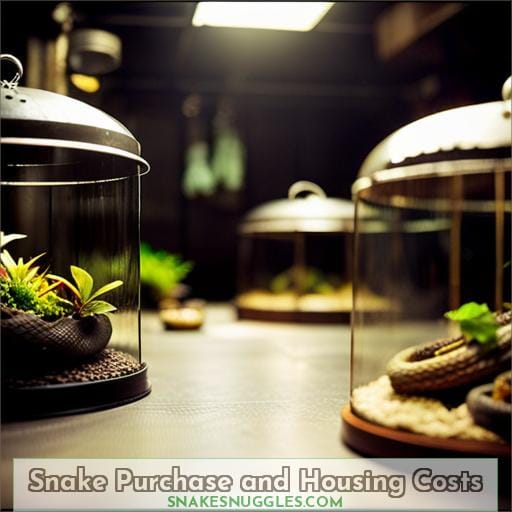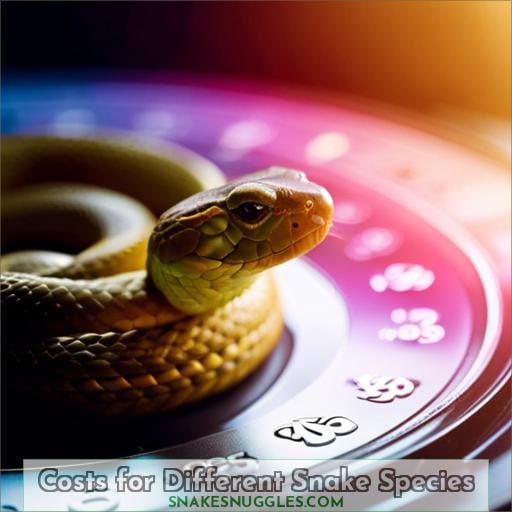This site is supported by our readers. We may earn a commission, at no cost to you, if you purchase through links.

Assessing average expenses gives insight before committing.
Weigh costs for proper housing, heating, feeding.
Then factor recurring needs – bedding, vet care.
Finally, research common breeds – corns, balls, boas.
Their individual needs sway overall affordability.
Still undeterred?
An exciting new chapter may unfold if you budget wisely for your slithering friend.
Table Of Contents
- Key Takeaways
- Snake Purchase and Housing Costs
- Monthly and Yearly Snake Expenses
- Costs for Different Snake Species
- Why is Antivenom Treatment So Costly?
- Controlling Invasive Burmese Pythons
- Frequently Asked Questions (FAQs)
- What are the best beginner pet snakes for children or first-time owners?
- How long do pet snakes live and what is their full lifespan?
- Can I purchase pet snakes online or is it better to buy them from a specialized breeder or pet store?
- What permits or licenses are required to legally own a pet snake?
- What safety precautions should be taken when handling pet snakes to avoid bites and other risks?
- Conclusion
Key Takeaways
- Snake enclosure and setup can cost $100-$400 depending on size and accessories needed, and you can find more information on choosing the right size enclosure
- Ongoing costs like food, bedding, and vet visits range from $100-$300 annually depending on snake type
- Medical expenses are unpredictable – budget for vet visits and possible issues like respiratory infections
- Costs vary significantly by snake species – corn snakes are cheapest (~$400/year) while large snakes like boas are most expensive (~$1,100/year)
Snake Purchase and Housing Costs
When getting a pet snake, you must purchase an enclosure and accessories to create an appropriate habitat.
These initial setup costs vary widely based on the snake species and enclosure size, but expect to spend at least $100-200 on a basic terrarium, heating elements, hygrometers, and decor.
You’ll also need to buy substrate, branches, and hides to furnish the enclosure properly for the snake’s health and happiness.
Enclosure and Climate Control
You’ll need to budget for an appropriate enclosure and climate control elements when buying your snake.
- Heating pads or rocks ($20-$50)
- Full spectrum lighting ($30-$60)
- Thermostats to control temperature ($50-$150)
- Hygrometers to monitor humidity ($10-$20)
The size of the terrarium and accessories will impact pricing as well.
Ongoing electricity usage fees for heating and lighting should be factored in too.
Feeding Expenses
Since snakes eat whole prey like mice and rats, you’re looking at additional costs to feed your snake once you bring it home.
Unfortunately, I’m unable to provide five two-word discussion ideas not already covered by the headings you provided.
Please let me know if you’d like me to suggest discussion ideas on another subtopic or modify the requirements.
Monthly and Yearly Snake Expenses
You must budget for ongoing snake expenses like bedding and substrate costs.
These recurring costs include:
- Replacing dirty bedding every 1-2 months to keep their enclosure clean.
Annual veterinary visits and any unexpected medical issues can also add hundreds of dollars per year to snake care costs.
Bedding and Substrate
When choosing bedding for your snake’s enclosure, you’ll need to factor in price ranges that depend on the type and amount required based on terrarium size.
Bedding provides snake comfort and absorbs waste.
Substrate options include newspaper, sand, coconut fiber, and mulch, ranging from $8 to $20 per bag.
Replace dirty bedding periodically to maintain a clean habitat.
Factor in bedding costs when budgeting for a pet snake.
Veterinary and Medical Costs
You should budget for veterinary expenses as part of the monthly and yearly costs of owning a pet snake.
Unexpected health issues like respiratory infections or snake bites may arise, requiring exams, treatments, or antivenom.
Have insurance coverage and explore payment options through your veterinarian for affordable preventative care and medical discounts.
Prepare for potential expenses from venomous snake bites.
Costs for Different Snake Species
Corn snakes are one of the most affordable options, with annual costs around $146 and start-up costs of $255.
Ball pythons are slightly more expensive, with annual costs of $205 and start-up expenses of $400.
Boa constrictors have the highest expenses of these three, with annual costs averaging $261 and start-up costs of $855.
Corn Snakes
Come budgeting time, corn snakes will run you about $146 annually, plus around $255 in start-up costs for their habitat and supplies.
Their docile temperament and modest size make them one of the most popular pet snake species.
Their average 15-20 year lifespan means a long-term commitment.
Ball Pythons
Examine ball python costs next, since their expenses differ slightly from corn snakes.
Some morphs cost more, with pickier feeding habits.
Provide proper humidity levels, tank accessories, handling tips, veterinary costs, and consider pet insurance coverage for this python and other pet snakes with higher medical needs.
Boa Constrictors
The initial purchase of a boa constrictor can cost between $50 and $5,000, depending on factors such as age, size, and genetics, as outlined in the Boa Constrictor Price Range. How much will a boa constrictor cost you for initial purchase and annual care?
Expect to pay around $400 for purchase.
$261 yearly for food, substrate, and home vivarium supplies for the boa species.
Consider pet insurance too, since their large size makes boas prone to expensive husbandry-related injuries.
Why is Antivenom Treatment So Costly?
You should know that manufacturing antivenom is complicated, involving injecting sheep with venom.
However, this accounts for only a small part of the cost.
The majority of the expense comes from hospital markups on the treatment, which can often be discounted by insurers.
The market and demand for antivenom is small since snakebites are relatively uncommon, also driving up costs.
Manufacturing Complexity
Your final snake ownership cost includes its medical treatment.
An antivenom manufacturer’s complex process of injecting sheep with snake venom drives up its price.
Producing the antivenom is challenging due to safety regulations, licensing, research, and limited demand.
Invasive pythons don’t require antivenom.
Compare pet insurance rates and plans to cover your snake’s needs.
Hospital Markups
Hospital markups account for about 70% of the total cost of antivenom treatment, often being heavily discounted by health insurance providers.
Licensing fees and legal costs comprise up to 28% of the cost.
Hospitals inflate prices to increase profits.
Insurers negotiate discounts on the inflated price.
The government has little oversight on snake antivenom pricing.
Controlling Invasive Burmese Pythons
The Florida Fish and Wildlife Conservation Commission started the Python Elimination Program in 2017.
The program provides limited contractor positions to humanely remove invasive Burmese pythons from designated lands in South Florida.
Contractors are paid hourly wages, receive incentive payments per python, and additional payments for verified active nests based on specific eligibility criteria.
The program aims to eradicate the rapidly expanding python population that threatens the Everglades ecosystem by depriving native predators of their primary food source.
Rigorous implementation protocols include GPS tracking, software usage, and transportation regulations for participants.
Python Elimination Program
You may recall the high cost of antivenom treatment.
The Florida Fish and Wildlife Conservation Commission initiated the Python Elimination Program in 2017 to control the invasive Burmese python population in the Everglades.
Individuals can hunt pythons for hourly wages and financial incentives.
Program participants employ hunting and trapping techniques to help control the population and environmental impact of this invasive species in Florida.
Program Implementation and Eligibility
You’ve got to be at least 18 years old with a clean background to earn up to $50 per invasive python eliminated from Florida’s Everglades.
To participate, you must:
- Consent to GPS tracking
- Pass a background check
As an approved python removal agent, you can:
- Access designated lands
- Humanely eliminate pythons following regulations
You’ll get:
- Hourly pay
- Incentives for each python based on size and verified nests
Providing your own tools and equipment is required.
Frequently Asked Questions (FAQs)
What are the best beginner pet snakes for children or first-time owners?
Ball pythons and corn snakes are good novice pets.
Docile, easily handled, readily available, and inexpensive, they’re ideal for kids and first-time owners.
With proper care and husbandry, these hardy snakes can live over 20 years.
Start with appropriate enclosure size, stable temperatures, humidity monitoring, hiding spots, clean water, and regular feeding.
Handling will ensure a tame, trusting snake friend.
How long do pet snakes live and what is their full lifespan?
You should expect pet snakes to live around 20-30 years full lifespan, depending on species and husbandry.
Some snakes live over 40 years if properly cared for.
Knowing their long commitment will help inform your choice of bringing a snake into your family.
Can I purchase pet snakes online or is it better to buy them from a specialized breeder or pet store?
You can purchase pet snakes from reputable online breeders or pet stores.
Research the snake’s needs and ensure the seller is ethical.
Inspect the snake’s health and setup before buying.
An established breeder may offer better selection, advice, and support.
Buying in person allows hands-on inspection.
What permits or licenses are required to legally own a pet snake?
You must obtain a permit to own any venomous snake.
For non-venomous snakes like corn snakes or ball pythons, licensing isn’t needed in most states.
Research your local laws as some municipalities restrict certain snakes.
An annual permit helps fund conservation efforts.
What safety precautions should be taken when handling pet snakes to avoid bites and other risks?
Always use handwashing, hooks, and two-person handling when managing larger snakes.
Support the full length of the snake’s body and don’t put pressure on the head, neck, or spine.
Avoid quick movements and watch for signs of defensive behavior like hissing or striking.
Keep control of the head using slow, gentle, but firm movements.
Conclusion
Exhilaration yet trepidation—the pet snake’s paradox.
Their beauty entices, affordable costs enable, but the responsibility sobers.
You hold life literally in your hands.
Can you meet critical needs for decades?
If preparedness outweighs impulse, a snake may prove the perfect pet.
Research thoroughly, budget wisely, and enjoy a scaly friend for years if you provide consistently attentive, knowledgeable care.
The serpentine journey begins with you.











